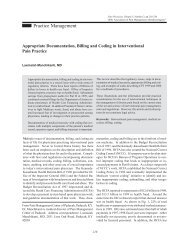ASIPP Practice Guidelines - Pain Physician
ASIPP Practice Guidelines - Pain Physician
ASIPP Practice Guidelines - Pain Physician
You also want an ePaper? Increase the reach of your titles
YUMPU automatically turns print PDFs into web optimized ePapers that Google loves.
Manchikanti et al • <strong>ASIPP</strong> <strong>Practice</strong> <strong>Guidelines</strong><br />
56<br />
study (564). Carette et al (258) also failed to include local<br />
anesthetic in the injection. In addition, Carette et al (258)<br />
used the same target level of epidural injection in all patients<br />
irrespective of location or pathology and discounted<br />
the short term facilitating effects of epidural steroid injections.<br />
There were also no structured co-interventions (258).<br />
Cuckler et al (560) included patients with prior surgery.<br />
They also evaluated responses at 24 hours which was felt<br />
to be inappropriate as it was quite a short period over which<br />
to evaluate the effectiveness of an invasive procedure and<br />
the anti-inflammatory effect of long-acting steroid preparation.<br />
In addition, they also made injections at the L3/4<br />
level in all of the patients rather than injecting close to the<br />
site of pathology. Bush and Hillier (571) study was not<br />
randomized and there were no outcome parameters.<br />
Fukusaki et al (580) utilized three epidural injections in a<br />
one week period with no pharmacologic basis, and failed<br />
to enter the epidural space in a significant number of patients.<br />
Interestingly none of the controlled studies were<br />
performed under fluoroscopic visualization.<br />
Numerous uncontrolled trials reported good results in 18%<br />
to 90% of patients receiving lumbar epidural steroid injections.<br />
Berman et al (583) reported good to excellent results<br />
at three months, six months, and one year in 87%,<br />
77% and 69% of patients, respectively. Brown (572) reported<br />
even better results with 80% relief at one year. Other<br />
selective uncontrolled trials also reported six months of<br />
relief in approximately 60% of the patients, and 1 year<br />
relief in 36% of the patients (573-578). Pawl et al (588),<br />
in evaluating the records of 136 patients with typical radicular<br />
symptoms reported that 29 patients or 80% indicated<br />
that the relief of pain from epidural steroid injection was<br />
50% or more, and 50% of the patients were able to avoid<br />
surgery with the help of epidural injections. Various other<br />
evaluations have shown success rates with cervical epidural<br />
injections varying from 64% to 79% for less than three<br />
months, 50% to 68% for 3 to 6 months, and 25%-68% for<br />
over 6 months (584-586, 591). Manchikanti et al (553)<br />
compared blind lumbar interlaminar epidural steroid injections<br />
with fluoroscopically directed caudal and transforaminal<br />
injections and concluded that blind interlaminar<br />
epidural injections were not cost effective.<br />
In terms of quality of the 13 studies considered in the<br />
interlaminar lumbar and cervical epidural steroid injections,<br />
two were of high quality (258, 567); six were of moderate<br />
quality (560, 561-563, 566, 568), whereas remaining five<br />
were of low quality (564, 565, 569-571). Of the 13 studies,<br />
three of nine interlaminar lumbar epidural steroid injections<br />
and three of three cervical epidural steroid injections<br />
were judged to be positive, while the remaining were<br />
considered negative (Table 11). Thus, evidence from controlled<br />
studies is predominantly negative for lumbar<br />
interlaminar and positive for cervical interlaminar epidural<br />
injections. However, multiple observational studies<br />
showed positive results. Hence, type and strength of efficacy<br />
evidence is level III to IV moderate to limited. Level<br />
III - moderate is defined as evidence from well-designed<br />
trials without randomization, single group pre-post, cohort,<br />
time series, or matched case controlled studies. Level IV<br />
- limited is defined as evidence from well-designed nonexperimental<br />
studies from more than one center or research<br />
group.<br />
Transforaminal Epidural Injections: Caudal epidural<br />
injection of drugs was introduced as the first type of entry<br />
into the epidural space in 1901, and transforaminal epidural<br />
injection was introduced as the first and earliest use of<br />
epidural steroids (315, 316). In 1952, Robechhi and Capra<br />
(315) administered periradicular injection of hydrocortisone<br />
into the first sacral nerve root and reported relief of<br />
lumbar and sciatic pain in a woman in the Italian literature.<br />
Subsequently, Lievre and colleagues (316) also reported<br />
transforaminal injection of steroids into the first<br />
sacral nerve root, in the French literature. The sacral transforaminal<br />
epidural injection of steroids was popularized<br />
largely in the Italian literature (315, 613-618), and to a<br />
lesser extent, in the French literature (316, 619-621). There<br />
were no significant American reports until 1971, when<br />
McNab described the diagnostic value of selective nerve<br />
root infiltration in patients with suspected radicular etiology<br />
of pain (405). In contrast to reports of caudal and<br />
interlaminar epidural injections, reports of transforaminal<br />
injections are sparse in the literature (622-631). Review<br />
of the literature showed three prospective, randomized<br />
controlled, trials (622-624); two prospective evaluations<br />
(571, 625); and multiple retrospective studies (415, 553,<br />
609, 626-628) (Table 12).<br />
Riew et al (622), in a prospective, randomized, controlled,<br />
double-blinded study, evaluated the effectiveness of transforaminal<br />
epidural cortical steroids in subjects with disc<br />
herniations and/or spinal stenosis. The study included 55<br />
patients with disc herniations or spinal stenosis referred<br />
for surgical evaluation. All subjects had clinical indications<br />
for surgery, and radiographic confirmation of nerve<br />
root compression. All had failed a minimum of 6 weeks of<br />
conservative care or had unrelenting pain. Exclusion criteria<br />
consisted of patients who had sustained trauma, patients<br />
with evidence of other serious diseases, patients demonstrating<br />
adverse reactions to the medications employed<br />
<strong>Pain</strong> <strong>Physician</strong> Vol. 4, No. 1, 2001
















